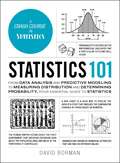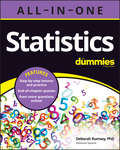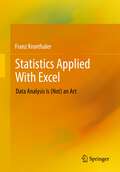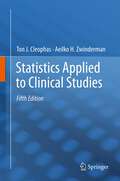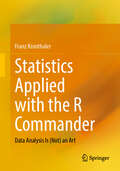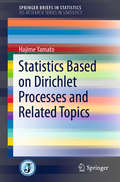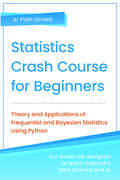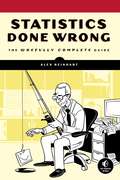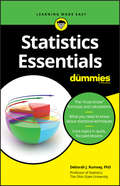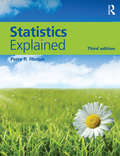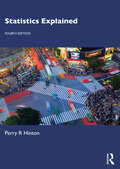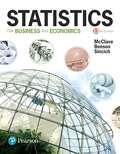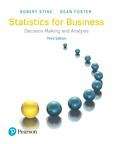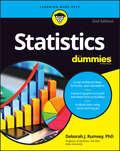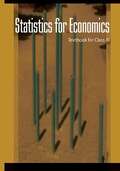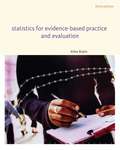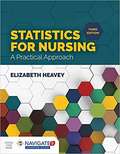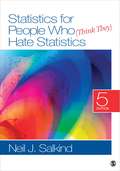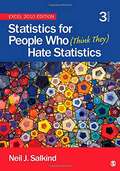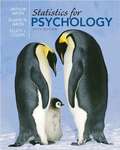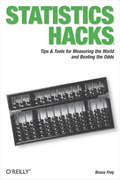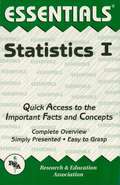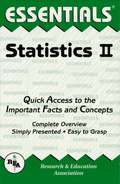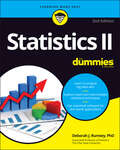- Table View
- List View
Statistics 101: From Data Analysis and Predictive Modeling to Measuring Distribution and Determining Probability, Your Essential Guide to Statistics (Adams 101)
by David BormanA comprehensive guide to statistics—with information on collecting, measuring, analyzing, and presenting statistical data—continuing the popular 101 series. Data is everywhere. In the age of the internet and social media, we’re responsible for consuming, evaluating, and analyzing data on a daily basis. From understanding the percentage probability that it will rain later today, to evaluating your risk of a health problem, or the fluctuations in the stock market, statistics impact our lives in a variety of ways, and are vital to a variety of careers and fields of practice. Unfortunately, most statistics text books just make us want to take a snooze, but with Statistics 101, you’ll learn the basics of statistics in a way that is both easy-to-understand and apply. From learning the theory of probability and different kinds of distribution concepts, to identifying data patterns and graphing and presenting precise findings, this essential guide can help turn statistical math from scary and complicated, to easy and fun. Whether you are a student looking to supplement your learning, a worker hoping to better understand how statistics works for your job, or a lifelong learner looking to improve your grasp of the world, Statistics 101 has you covered.
Statistics All-in-One For Dummies
by Deborah J. RumseyThe odds-on best way to master stats. Statistics All-in-One For Dummies is packed with lessons, examples, and practice problems to help you slay your stats course. Develop confidence and understanding in statistics with easy-to-understand (even fun) explanations of key concepts. Plus, you’ll get access to online chapter quizzes and other resources that will turn you into a stats master. This book teaches you how to interpret graphs, determine probability, critique data, and so much more. Written by an expert author and serious statistics nerd, Statistics AIO For Dummies explains everything in terms anyone can understand. Get a grasp of basic statistics concepts required in every statistics course Clear up the process of interpreting graphs, understanding polls, and analyzing data Master correlation, regression, and other data analysis tools Score higher on stats tests and get a better grade in your high school or college classStatistics All-in-One For Dummies follows the curriculum of intro college statistics courses (including AP Stats!) so you can learn everything you need to know to get the grade you need—the Dummies way.
Statistics Applied With Excel: Data Analysis Is (Not) an Art
by Franz KronthalerThis book shows you how to analyze data sets systematically and to use Excel 2019 to extract information from data almost effortlessly. Both are (not) an art!The statistical methods are presented and discussed using a single data set. This makes it clear how the methods build on each other and gradually more and more information can be extracted from the data. The Excel functions used are explained in detail - the procedure can be easily transferred to other data sets. Various didactic elements facilitate orientation and working with the book: At the checkpoints, the most important aspects from each chapter are briefly summarized. In the freak knowledge section, more advanced aspects are addressed to whet the appetite for more. All examples are calculated with hand and Excel. Numerous applications and solutions as well as further data sets are available on the author's internet platform. This book is a translation of the original German 2nd edition Statistik angewandt mit Excel by Franz Kronthaler, published by Springer-Verlag GmbH Germany, part of Springer Nature in 2021. The translation was done with the help of artificial intelligence (machine translation by the service DeepL.com). A subsequent human revision was done primarily in terms of content, so that the book will read stylistically differently from a conventional translation. Springer Nature works continuously to further the development of tools for the production of books and on the related technologies to support the authors.
Statistics Applied to Clinical Studies
by Aeilko H. Zwinderman Ton J. CleophasThanks to the omnipresent computer, current statistics can include data files of many thousands of values, and can perform any exploratory analysis in less than seconds. This development, however fascinating, generally does not lead to simple results. We should not forget that clinical studies are, mostly, for confirming prior hypotheses based on sound arguments, and the simplest tests provide the best power and are adequate for such studies. In the past few years the authors of this 5th edition, as teachers and research supervisors in academic and top-clinical facilities, have been able to closely observe the latest developments in the field of clinical data analysis, and they have been able to assess their performance. In this 5th edition the 47 chapters of the previous edition have been maintained and upgraded according to the current state of the art, and 20 novel chapters have been added after strict selection of the most valuable and promising novel methods. The novel methods are explained using practical examples and step-by-step analyses readily accessible for non-mathematicians. All of the novel chapters have been internationally published by the authors in peer-reviewed journal, including the American Journal of Therapeutics, the European Journal of Clinical Investigation, The International journal of Clinical Pharmacology and therapeutics, and other journals, and permission is granted by all of them to use this material in the current book. We should add that the authors are well-qualified in their fields of knowledge. Professor Zwinderman is president-elect of the International Society of Biostatistics, and Professor Cleophas is past-president of the American College of Angiology. From their expertise they should be able to make adequate selections of modern methods for clinical data analysis for the benefit of physicians, students, and investigators. The authors, although from a different discipline, one clinician and one statistician, have been working and publishing together for over 10 years, and their research of statistical methodology can be characterized as a continued effort to demonstrate that statistics is not mathematics but rather a discipline at the interface of biology and mathematics. They firmly believe that any reader can benefit from this clinical approach to statistical data analysis.
Statistics Applied with the R Commander: Data Analysis Is (Not) an Art
by Franz KronthalerThis book shows you how to analyze data sets systematically and to use the R Commander to extract information from data almost effortlessly. Both are (not) an art! The statistical methods are presented and discussed using a single data set. This makes it clear how the methods build on each other and gradually more and more information can be extracted from the data. R and the R Commander functions used are explained in detail – the procedure can be easily transferred to other data sets. The book thus provides a simple introduction to professional and free statistical software. Various didactic elements facilitate orientation and working with the book: At the checkpoints, the most important aspects from each chapter are briefly summarized. In the freak knowledge section, more advanced aspects are addressed to whet the appetite for more. All examples are calculated with hand and the R Commander. Numerous applications and solutions as well as further data sets are available on the author's internet platform. This book is a translation of the original German 2nd edition Statistik angewandt mit dem R Commander by Franz Kronthaler, published by Springer-Verlag GmbH Germany, part of Springer Nature in 2021. The translation was done with the help of artificial intelligence (machine translation by the service DeepL.com). A subsequent human revision was done primarily in terms of content, so that the book will read stylistically differently from a conventional translation. Springer Nature works continuously to further the development of tools for the production of books and on the related technologies to support the authors.
Statistics Based on Dirichlet Processes and Related Topics (SpringerBriefs in Statistics)
by Hajime YamatoThis book focuses on the properties associated with the Dirichlet process, describing its use a priori for nonparametric inference and the Bayes estimate to obtain limits for the estimable parameter. It presents the limits and the well-known U- and V-statistics as a convex combination of U-statistics, and by investigating this convex combination, it demonstrates these three statistics. Next, the book notes that the Dirichlet process gives the discrete distribution with probability one, even if the parameter of the process is continuous. Therefore, there are duplications among the sample from the distribution, which are discussed. Because sampling from the Dirichlet process is described sequentially, it can be described equivalently by the Chinese restaurant process. Using this process, the Donnelly–Tavaré–Griffiths formulas I and II are obtained, both of which give the Ewens’ sampling formula. The book then shows the convergence and approximation of the distribution for its number of distinct components. Lastly, it explains the interesting properties of the Griffiths–Engen–McCloskey distribution, which is related to the Dirichlet process and the Ewens’ sampling formula.
Statistics Crash Course for Beginners: Theory and applications of Frequentist and Bayesian statistics using Python
by AI Sciences OUA beginner-friendly crash course to statistics utilizing Python with an eye to preparing students for further study in machine learningKey FeaturesA quick introduction to Python for statisticsHands-on projects for guided practiceInstant access to PDFs, Python codes, exercises, and references on the publisher's website at no extra costBook DescriptionData and statistics are the core subjects of Machine Learning (ML). The reality is that the average programmer may be tempted to view statistics with disinterest. But if you want to exploit the incredible power of ML, you need a thorough understanding of statistics. The reason is that a machine learning professional develops intelligent and fast algorithms that learn from data. This Statistics Crash Course for Beginners presents you with an easy way of learning statistics fast.Contrary to popular belief, statistics is no longer the exclusive domain of math PhDs. It's true that statistics deals with numbers and percentages. Hence, the subject can be very dry and boring. This book, however, transforms statistics into a fun subject.Frequentist and Bayesian statistics are two statistical techniques that interpret the concept of probability in different ways. Bayesian statistics was first introduced by Thomas Bayes in the 1770s. Bayesian statistics has been instrumental in the design of high-end algorithms that make accurate predictions. So, even after 250 years, the interest in Bayesian statistics has not faded. In fact, it has accelerated tremendously.Frequentist statistics is just as important as Bayesian statistics. In the statistical universe, Frequentist statistics is the most popular inferential technique. In fact, it's the first school of thought you come across when you enter the statistics world.By the end of this course, you will have built a solid foundation in statistical theory and practice that will prepare you for further study in machine learning and a career in programming. The code bundle for this course is available at https://www.aispublishing.net/nlp-crash-course1605125706681What you will learnGet a crash course in Python for statisticsUtilize Python to determine probability, random variables, and probability distributionsStudy descriptive statistics, measuring central tendency and spreadPerform exploratory analysis, such as data visualizationPractice statistical inference, frequentist inference, and Bayesian inferenceSuccessfully complete several real-world projectsWho this book is forThis course is intended for anyone interested in learning Frequentist and Bayesian statistics, either as a first step to machine learning or basic programming. No prior experience is required.
Statistics Done Wrong
by Alex ReinhartScientific progress depends on good research, and good research needs good statistics. But statistical analysis is tricky to get right, even for the best and brightest of us. You'd be surprised how many scientists are doing it wrong.Statistics Done Wrong is a pithy, essential guide to statistical blunders in modern science that will show you how to keep your research blunder-free. You'll examine embarrassing errors and omissions in recent research, learn about the misconceptions and scientific politics that allow these mistakes to happen, and begin your quest to reform the way you and your peers do statistics.You'll find advice on:–Asking the right question, designing the right experiment, choosing the right statistical analysis, and sticking to the plan–How to think about p values, significance, insignificance, confidence intervals, and regression–Choosing the right sample size and avoiding false positives–Reporting your analysis and publishing your data and source code–Procedures to follow, precautions to take, and analytical software that can helpScientists: Read this concise, powerful guide to help you produce statistically sound research. Statisticians: Give this book to everyone you know.The first step toward statistics done right is Statistics Done Wrong.
Statistics Essentials For Dummies
by Deborah J. RumseyStatistics Essentials For Dummies (9781119590309) was previously published as Statistics Essentials For Dummies (9780470618394). While this version features a new Dummies cover and design, the content is the same as the prior release and should not be considered a new or updated product. Statistics Essentials For Dummies not only provides students enrolled in Statistics I with an excellent high-level overview of key concepts, but it also serves as a reference or refresher for students in upper-level statistics courses. Free of review and ramp-up material, Statistics Essentials For Dummies sticks to the point, with content focused on key course topics only. It provides discrete explanations of essential concepts taught in a typical first semester college-level statistics course, from odds and error margins to confidence intervals and conclusions. This guide is also a perfect reference for parents who need to review critical statistics concepts as they help high school students with homework assignments, as well as for adult learners headed back into the classroom who just need a refresher of the core concepts. The Essentials For Dummies SeriesDummies is proud to present our new series, The Essentials For Dummies. Now students who are prepping for exams, preparing to study new material, or who just need a refresher can have a concise, easy-to-understand review guide that covers an entire course by concentrating solely on the most important concepts. From algebra and chemistry to grammar and Spanish, our expert authors focus on the skills students most need to succeed in a subject.
Statistics Explained
by Perry R. HintonStatistics Explained is an accessible introduction to statistical concepts and ideas. It makes few assumptions about the reader’s statistical knowledge, carefully explaining each step of the analysis and the logic behind it. The book: provides a clear explanation of statistical analysis and the key statistical tests employed in analysing research data gives accessible explanations of how and why statistical tests are used includes a wide range of practical, easy-to-understand worked examples. Building on the international success of earlier editions, this fully updated revision includes developments in statistical analysis, with new sections explaining concepts such as bootstrapping and structural equation modelling. A new chapter - ‘Samples and Statistical Inference’ - explains how data can be analysed in detail to examine its suitability for certain statistical tests. The friendly and straightforward style of the text makes it accessible to all those new to statistics, as well as more experienced students requiring a concise guide. It is suitable for students and new researchers in disciplines including Psychology, Education, Sociology, Sports Science, Nursing, Communication, and Media and Business Studies. Presented in full colour and with an updated, reader-friendly layout, this new edition also comes with a companion website featuring supplementary resources for students. Unobtrusive cross-referencing makes it the ideal companion to Perry R. Hinton’s SPSS Explained, also published by Routledge. Perry R. Hinton has many years of experience in teaching statistics to students from a wide range of disciplines and his understanding of the problems students face forms the basis of this book.
Statistics Explained
by Perry R. HintonStatistics Explained, now in its fully revised Fourth Edition, is for students and researchers who wish to understand the statistical analyses used to analyse quantitative (numerical) research data in a wide range of academic disciplines, in particular, the behavioural, human and social sciences.This book explains, in a clear and informative manner, the logic of statistical analysis, in particular the null hypothesis significance testing (NHST) method. Using this method, a range of statistical tests have been devised for different types of data. Each of these tests is explained in the book by adopting a step-by-step (“walkthrough”) approach with a specific illustrative example. Crucially, these explanations do not require the reader to have an advanced knowledge of mathematics or statistics, but only assumes the basic mathematics which most readers will have learnt at high school. The book also examines the criticisms of NHST and introduces the reader to Bayesian statistics. As a result the reader will be able to critically evaluate the outcomes of statistical analysis both of their own work and that of others.Statistics Explains will be of great interest to students and researchers in the behavioural, human and social sciences in understanding both the outcomes of their own research and also the research reports in the academic journals.
Statistics Explained
by Steve MckillupAn understanding of statistics and experimental design is essential for life science studies, but many students lack a mathematical background and some even dread taking an introductory statistics course. Using a refreshingly clear and encouraging reader-friendly approach, this book helps students understand how to choose, carry out, interpret and report the results of complex statistical analyses, critically evaluate the design of experiments and proceed to more advanced material. Taking a straightforward conceptual approach, it is specifically designed to foster understanding, demystify difficult concepts and encourage the unsure. Even complex topics are explained clearly, using a pictorial approach with a minimum of formulae and terminology. Examples of tests included throughout are kept simple by using small data sets. In addition, end-of-chapter exercises, new to this edition, allow self-testing. Handy diagnostic tables help students choose the right test for their work and remain a useful refresher tool for postgraduates.
Statistics For Business And Economics
by Terry Sincich P. George Benson James McClaveThirteenth Edition, Statistics for Business and Economics introduces statistics in the context of contemporary business. Emphasizing statistical literacy in thinking, the text applies its concepts with real data and uses technology to develop a deeper conceptual understanding. Examples, activities, and case studies foster active learning while emphasizing intuitive concepts of probability and teaching readers to make informed business decisions. The Thirteenth Edition continues to highlight the importance of ethical behavior in collecting, interpreting, and reporting on data, while also providing a wealth of new and updated exercises and case studies.
Statistics For Business: Decision Making And Analysis
by Robert A. Stine Dean P. FosterUnderstand Business. Understand Data. The 3rd Edition of Statistics for Business: Decision Making and Analysis emphasizes an application-based approach, in which readers learn how to work with data to make decisions. In this contemporary presentation of business statistics, readers learn how to approach business decisions through a 4M Analytics decision making strategy—motivation, method, mechanics and message—to better understand how a business context motivates the statistical process and how the results inform a course of action. Each chapter includes hints on using Excel, Minitab Express, and JMP for calculations, pointing the reader in the right direction to get started with analysis of data.
Statistics For Dummies
by Deborah J. RumseyThe fun and easy way to get down to business with statisticsStymied by statistics? No fear ? this friendly guide offers clear, practical explanations of statistical ideas, techniques, formulas, and calculations, with lots of examples that show you how these concepts apply to your everyday life.Statistics For Dummies shows you how to interpret and critique graphs and charts, determine the odds with probability, guesstimate with confidence using confidence intervals, set up and carry out a hypothesis test, compute statistical formulas, and more.Tracks to a typical first semester statistics courseUpdated examples resonate with today's studentsExplanations mirror teaching methods and classroom protocolPacked with practical advice and real-world problems, Statistics For Dummies gives you everything you need to analyze and interpret data for improved classroom or on-the-job performance.
Statistics For Economics class 11 - NCERT - 23
by National Council of Educational Research and TrainingThe "STATISTICS FOR ECONOMICS" textbook by NCERT for Class XI is an essential guide for students venturing into the realm of economic data analysis. This resource demystifies the complex world of statistics, making it accessible for budding economists. Beginning with an introduction to the significance of statistics in economics, it delves into the techniques of data collection, organization, and presentation. The textbook elucidates central tendencies, dispersions, and correlations, highlighting their relevance in economic scenarios. Students are also introduced to index numbers and their applications in economic data interpretation. Special attention is given to the use of graphical and tabular methods for data presentation, providing students with practical tools to understand and analyze economic trends. By the end of the book, students are well-equipped with foundational statistical concepts, tailored specifically for economic applications, preparing them for advanced studies and real-world economic data analysis.
Statistics For Evidence-Based Practice And Evaluation
by Allen RubinBoth practical and easy to read, Rubin's STATISTICS FOR EVIDENCE-BASED PRACTICE AND EVALUATION provides you with a step-by-step guide that will help you succeed in your course. Practice illustrations and exercises support your ability to study and retain core concepts, while practical examples provide you with the opportunity to see how and when data analysis and statistics are used by helping professionals in the real world.
Statistics For Nursing: A Practical Approach
by Elizabeth HeaveyEach new print copy includes Navigate 2 Advantage Access that unlocks a comprehensive and interactive eBook, student practice activities and assessments, a full suite of instructor resources, and learning analytics reporting tools. Statistics for Nursing: A Practical Approach, Third Edition is designed in accordance with the Conversation Theory of Gordon Pask and presents the complicated topic of statistics in an understandable manner for entry level nurses. The underlying principle of this design is to give students the opportunity to practice statistics while they learn statistics. The text accomplishes this through the inclusion of relevant clinical examples followed by end of chapter application exercises. The Third Edition has been updated with practice activities which enable students to apply the content they have learned. In addition, the authors have included new research articles to develop and reinforce literature critiquing skills. These new features provide more opportunities for students to apply the concepts learned while the explanations are beneficial to clinical experts interested in further developing evidence-based skills. This text meets the needs of both undergraduate nursing research students who need to learn how to critically analyze literature as well as graduate DNP students who must also be familiar with statistics for nursing in accordance with the rigor of the DNP program. New to the Third Edition: • Additional review questions • New and updated graphs and figures • Updated lesson content for computer application exercises
Statistics For People Who (Think They) Hate Statistics (Fifth Edition)
by Neil J. SalkindThe best-selling Statistics for People Who (Think They) Hate Statistics is now in its Fifth Edition Continuing its hallmark use of humor and common sense, this text helps students develop an understanding of an often intimidating and difficult subject with an approach that is informative, personable, and clear. Author Neil J. Salkind takes students through various statistical procedures, beginning with a brief historical introduction to statistics, correlation and graphical representation of data, and ending with inferential techniques and analysis of variance. The book provides examples using SPSS and includes reviews of measurement topics, such as reliability, validity, and also introductory non-parametric statistics. With more examples than ever before, the new edition offers a new Real World Stats feature at the end of each chapter. In addition, an enhanced interactive eBook edition (available spring 2014) features animated chapter introductions, quick quizzes, video clips, and more The Fifth Edition is also the basis for the Excel edition for the book of the same name
Statistics For People Who (Think They) Hate Statistics: Excel 2010 Edition
by Neil J. SalkindThe bestselling text Statistics for People Who (Think They) Hate Statistics is the basis for this completely adapted Excel 2010 version. Author Neil J. Salkind presents an often intimidating and difficult subject in a way that is informative, personable, and clear. Researchers and students who find themselves uncomfortable with the analysis portion of their work will appreciate this book′s unhurried pace and thorough, friendly presentation. Salkind begins the Excel version with a complete introduction to the software, and shows the students how to install the Excel Analysis ToolPak option (free) to earn access to a host of new and very useful analytical techniques. He then walks students through various statistical procedures, beginning with correlations and graphical representation of data and ending with inferential techniques and analysis of variance. Pedagogical features include sidebars offering additional technical information about the topic and set-off points that reinforce major themes. Finally, questions to chapter exercises, a complete glossary, and extensive Excel functionality are located at the back of the book. This Third Edition is updated for use with Excel 2010.
Statistics For Psychology
by Elaine Aron Arthur Aron Elliot CoupsThis author team is committed to making statistics a highlight for psychology students! Now, in a 5th edition, Statistics for Psychology, continues to be an accessible, current, and interesting approach to statistics. With each revision, the authors have maintain those things about the book that have been especially appreciated, while reworking the text to take into account the feedback, their our own experiences, and advances and changes in the field. The fifth edition of this popular text uses definitional formulas to emphasize concepts of statistics, rather than rote memorization. This approach constantly reminds students of the logic behind what they are learning, and each procedure is taught both verbally and numerically, which helps to emphasize the concepts. Thoroughly revised, with new content and many new practice examples, this text takes the reader from basic procedures through analysis of variance (ANOVA). While learning statistics, students also learn how to read and interpret current research.
Statistics Hacks: Tips & Tools for Measuring the World and Beating the Odds
by Bruce FreyWant to calculate the probability that an event will happen? Be able to spot fake data? Prove beyond doubt whether one thing causes another? Or learn to be a better gambler? You can do that and much more with 75 practical and fun hacks packed into Statistics Hacks. These cool tips, tricks, and mind-boggling solutions from the world of statistics, measurement, and research methods will not only amaze and entertain you, but will give you an advantage in several real-world situations-including business.This book is ideal for anyone who likes puzzles, brainteasers, games, gambling, magic tricks, and those who want to apply math and science to everyday circumstances. Several hacks in the first chapter alone-such as the "central limit theorem,", which allows you to know everything by knowing just a little-serve as sound approaches for marketing and other business objectives. Using the tools of inferential statistics, you can understand the way probability works, discover relationships, predict events with uncanny accuracy, and even make a little money with a well-placed wager here and there.Statistics Hacks presents useful techniques from statistics, educational and psychological measurement, and experimental research to help you solve a variety of problems in business, games, and life. You'll learn how to:Play smart when you play Texas Hold 'Em, blackjack, roulette, dice games, or even the lotteryDesign your own winnable bar bets to make money and amaze your friendsPredict the outcomes of baseball games, know when to "go for two" in football, and anticipate the winners of other sporting events with surprising accuracyDemystify amazing coincidences and distinguish the truly random from the only seemingly random--even keep your iPod's "random" shuffle honestSpot fraudulent data, detect plagiarism, and break codesHow to isolate the effects of observation on the thing observedWhether you're a statistics enthusiast who does calculations in your sleep or a civilian who is entertained by clever solutions to interesting problems, Statistics Hacks has tools to give you an edge over the world's slim odds.
Statistics I Essentials
by Emil G. MilewskiREA's Essentials provide quick and easy access to critical information in a variety of different fields, ranging from the most basic to the most advanced. As its name implies, these concise, comprehensive study guides summarize the essentials of the field covered. Essentials are helpful when preparing for exams, doing homework and will remain a lasting reference source for students, teachers, and professionals. Statistics I covers include frequency distributions, numerical methods of describing data, measures of variability, parameters of distributions, probability theory, and distributions.
Statistics II Essentials
by Emil MilewskiREA's Essentials provide quick and easy access to critical information in a variety of different fields, ranging from the most basic to the most advanced. As its name implies, these concise, comprehensive study guides summarize the essentials of the field covered. Essentials are helpful when preparing for exams, doing homework and will remain a lasting reference source for students, teachers, and professionals. Statistics II discusses sampling theory, statistical inference, independent and dependent variables, correlation theory, experimental design, count data, chi-square test, and time series.
Statistics II For Dummies
by Deborah J. RumseyContinue your statistics journey with this all-encompassing reference Completed Statistics through standard deviations, confidence intervals, and hypothesis testing? Then you’re ready for the next step: Statistics II. And there’s no better way to tackle this challenging subject than with Statistics II For Dummies! Get a brief overview of Statistics I in case you need to brush up on earlier topics, and then dive into a full explanation of all Statistic II concepts, including multiple regression, analysis of variance (ANOVA), Chi-square tests, nonparametric procedures, and analyzing large data sets. By the end of the book, you’ll know how to use all the statistics tools together to create a great story about your data. For each Statistics II technique in the book, you get an overview of when and why it’s used, how to know when you need it, step-by-step directions on how to do it, and tips and tricks for working through the solution. You also find: What makes each technique distinct and what the results say How to apply techniques in real life An interpretation of the computer output for data analysis purposes Instructions for using Minitab to work through many of the calculations Practice with a lot of examples With Statistics II For Dummies, you will find even more techniques to analyze a set of data. Get a head start on your Statistics II class, or use this in conjunction with your textbook to help you thrive in statistics!
